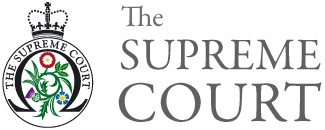Venue hire
New artwork
In addition to the Middlesex Guildhall Art collection, The Supreme Court building also has a wide ranging variety of new artwork.
- Supreme Court emblem
- Queen Elizabeth II bas-relief sculpture
- Entrance hall
- Court 1
- Lord Bingham portrait- Oil on canvas
- Middlesex Guildhall lectern
- Three Presidents
- Courtroom 2
- Welsh slate clock
- Legacy by Catherine Yass in Courtroom 2
- Library
- Supreme Court poem
- Lord Phillips: pencil on paper
- In appreciation: Mixed on canvas
- A limited edition print by Feliks Topolski RA
- Dame Margaret Kidd by an unknown photographer
- Illustration of Middlesex Guildhall by Stephen Wiltshire
- Signed print of Lord Denning, by Michael Noakes
- Side by Side - the sounds and story of Parliament square
Supreme Court emblem
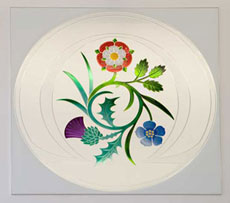
The Supreme Court’s official emblem was designed by Yvonne Holton, Herald Painter at the Court of Lord Lyon in Scotland. It uses traditional symbolism, yet is delicate and modern at the same time.
The emblem combines four heraldic elements, equally represented in the design, reflecting the jurisdictions within the United Kingdom:
- England: a symmetrical five-petalled wild rose, with stalk and leaves, an English symbol since the Tudor dynasty
- Wales: the green leaves of a leek, deriving from the medieval legend that St David ordered his Welsh soldiers to wear leeks on their helmets during a battle against the Saxons
- Scotland: a purple thistle, associated with the tradition that an early Scottish army was saved when barefooted Viking invaders stepped on prickly thistles in the dark, crying out in pain and waking the defenders
- Northern Ireland: a light blue five-petalled flax flower, representing the linen-weaving industry which was so valuable that nineteenth century Belfast was known as ‘Linenopolis’
These four national elements are embraced by an almost-circular frame representing both Libra, the scales of justice, and Omega, symbolising the final source of justice for the United Kingdom.
At its most formal level, the Royal Crown surmounts the emblem, as the Monarch is the source of The Supreme Court’s authority.
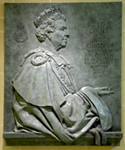
Queen Elizabeth II bas-relief sculpture
A bronze bas-relief of Queen Elizabeth II is mounted in the lobby area towards the front of the Court.
The sculpture, made by Ian Rank-Broadley, was unveiled by Her Majesty at the official opening of the Court on 16 October 2009.
Ian Rank-Broadley is one of the U.K.’s leading sculptors and it is his image of the Queen that appears on U.K. and Commonwealth coins.
Entrance hall

The designers Feilden + Mawson had a vision for the entrance to The Supreme Court that would be more striking than the small door leading into the Middlesex Guildhall.
The wooden double doors at the front of the building open into the entrance hall, where visitors are met by the emblem of The Supreme Court emblazoned on glass panels. On ceremonial days these are opened and lead to double doors into the Library. In turn the Library doors are etched with the Magna Carta.
The entrance hall’s functionality is balanced with decorative inscriptions on floor to ceiling glass panels. Designed by Bettina Furnee, these combine elements of The Supreme Court emblem and phrases of the Judicial Oath etched on to the glass.
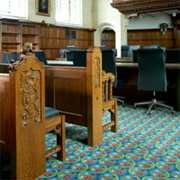
Court 1
All three court rooms are furnished with custom-made crescent shaped benches for the Justices and legal teams.
An important aspect of the renovation involved converting the court rooms from their previous imposing, adversarial atmosphere to an environment of discussion and debate. Much of the The original Middlesex Council Chamber furniture had fallen into disrepair, and has been modified for more modern use.
The pop-art carpet designed by Sir Peter Blake of 'Sergeant Pepper' fame brightens up the room with symbols representing the four nations of the United Kingdom.
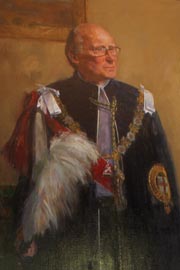
Lord Bingham portrait - Oil on canvas
This oil painting of the late Lord Bingham (13 October 1933 - 11 September 2010), which hangs in Court 1, was kindly donated to The Supreme Court by his widow Lady Bingham.
The portrait shows Lord Bingham in his Garter Robes.
Thomas Bingham had served as Senior Lord of Appeal in Ordinary between 6 June 2000- 30 September 2008.
The portrait was created by David Poole, a former President of the Royal Society of Portrait Painters and Chairman of the Federation of British Artists. He is Senior Lecturer at the Wimbledon School of Art, which is where he originally trained as an artist.
He has painted a number of members of the Government, and people from industry, commerce, medicine, academia, and the legal profession.
The Middlesex Guildhall lectern
This lectern and stand, which are exhibited outside Court One, were commissioned by a group of Judges, led by His Honour Judge Blacksell QC, who formerly sat in the Crown Court at the Middlesex Guildhall.
The lectern was created from wood used in the old Council Chamber (now Court One), and was designed and built by David Stanton.
The lectern was presented to The Supreme Court of the United Kingdom (UKSC) in March 2010 and is used regularly at events held in the UKSC.
Three Presidents
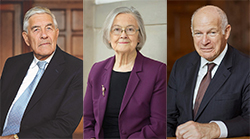
The Supreme Court Arts Trust commissioned three photographic portraits of our first three Supreme Court Presidents:
- Lord Phillips of Worth Matravers
1 October 2009 to 30 September 2012 - Lord Neuberger of Abbotsbury
1 October 2012 to 4 September 2017 - Lady Hale of Richmond
1 October 2017 to 10 January 2020.
The portraits, taken by photographer, Paul Stuart, were officially unveiled at a special event in July 2019 as part of our ten-year anniversary celebrations.
The portraits are now on display just outside Courtroom 1.
Courtroom 2
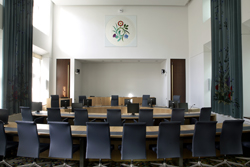
The most modern of the three court rooms, Courtroom Two was returned to its original height and dimensions.
The walls are decorated with wall hangings by Timorous Beasties and a large glass sculpture of The Supreme Court emblem.
On entry to the room visitors can either stand behind an etched glass screen to watch proceedings, or enter the Court itself and sit in the public gallery.
The screen is etched with the words: “Justice cannot be for one side alone but must be for both”.
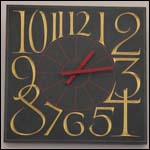
Welsh slate clock for The Supreme Court
A contemporary design by Richard Kindersley, the Welsh slate clock hangs aloft at 600mm x600mm in Court 2.
The numerals have been gilded with English gold leaf.
The hour lines have been carved to the edge of the dial and painted in red, thus providing a central focus for the bespoke hour and minute hands on a black slated background.
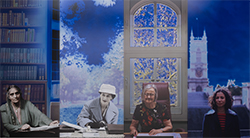
Legacy by Catherine Yass in Courtroom 2
Legacy, celebrating one hundred years of women in law and commemorating the centenary of the Sex Disqualification (Removal) Act was unveiled in the Courtroom 2 in December 2019.
The artwork was commissioned by Spark 21, the charity which manages the First 100 Years campaign. Created by the internationally recognised artist, Catherine Yass, Legacy features portraits of three female legal pioneers:
- Cornelia Sorabji, the first woman to sit the Bachelor of Civil Laws exam at Oxford University, and who often acted without charge to represent poor women in India
- Dame Rose Heilbron, one of the first two women to gain a first-class honours degree in law in 1935 and who secured the right of women to withhold their identity in rape cases
- Lady Hale of Richmond DBE, President of the Supreme Court from October 2017 to January 2020
A fourth image features an unnamed student, representing the potential of the next generation of women lawyers to shape our society through their practice and reforms.
Library

At the heart of the building is the law library, a triple-height space created for the Justices and their assistants to contemplate and study case law.
Dark wood shelves are set off by red leather reading surfaces, and an enlarged emblem woven into the carpet on the ground floor. The ceiling is magnificently rendered and painted to look like stone, and a wood and glass balustrade is engraved with pithy quotes chosen by the Justices themselves:
- 'Man, when perfected, is the best of animals, but when separated from law and justice he is the worst of all' - Aristotle
- 'No written laws can be so plain, so pure, but wit may gloss, and malice may obscure' - John Dryden
- 'Peace is not the absence of war it is a virtue, a state of mind, a disposition for benevolence, confidence, justice' - Baruch Spinoza
- 'Good actions give strength to ourselves and inspire good actions in others' - Plato
- 'Law is order and good law is good order' - Aristotle
- 'He who commits injustice is ever made more wretched than he who suffers it' - Plato
- 'These having not the law are a law unto themselves' - Romans 2:14
- 'Injustice anywhere is a threat to justice everywhere. We are caught in an inescapable web of mutuality, tied in a single garment of destiny. Whatever affects one directly affects all indirectly' - Martin Luther King
- 'The first duty of a man is the seeking after and the investigation of truth' - Cicero
- 'Justice is truth in action' - Benjamin Disraeli
- 'Justice is far from being a natural concept. The closer one goes to the state of nature, the less does one find' - Robert Megarry
- 'Where is there any book of the law so clear to each man as that written in his heart?' - Leo Tolstoy
- 'A man is a little thing while he works by and for himself, but when he gives voice to the rules of love and justice he is godlike' - Ralph Waldo Emerson
- 'It is in justice that the ordering of society is centred' - Aristotle
- 'Laws were made to prevent the strong from always having their way' - Ovid
- 'Judges ought to be more learned than witty, more reverend than plausible and more advised than confident' - Francis Bacon
Supreme Court poem
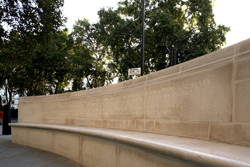
The Supreme Court poem was written by Andrew Motion, Poet Laureate between 1999 - 2009, to mark the creation of the Supreme Court.
The poem is enscribed on the semi-circular stone benches opposite the main entrance.
Lines for The Supreme Court
Tides tumbled sand through seas long-lost to earth;
Sand hardened into-stone – stone cut, then brought
To frame the letter of our four nations’ law
And square the circle of a single court.
Here Justice sits and lifts her steady scales
Within the Abbey’s sight and Parliaments
But independent of them both. And bound
By truth of principle and argument.
A thousand years of judgment stretch behind –
The weight of rights and freedoms balancing
With fairness and with duty to the world:
The clarity time-honoured thinking brings.
New structures but an old foundation stone:
The mind of Justice still at liberty
Four nations separate but linked as one:
The light of reason falling equally.
Andrew Motion, Poet Laureate 1999-2009
Lord Phillips: pencil on paper
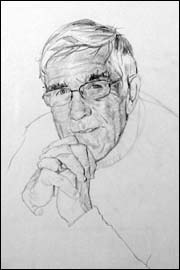
Henry Casselli, from New Orleans in the United States, has undertaken a number of challenging and high-profile commissions during his 50-year long career, including periods as an official artist during both the Vietnam War and NASA's preparations for its first space shuttle launch.
He was also commissioned to paint President Ronald Reagan during his time in the White House, and granted just a few hours to make sketches in preparation for a life-size oil painting which today hangs in the National Portrait Gallery in Washington DC. It has been said of his preparations for the Reagan portrait that "The drawings are remarkable likenesses, conveying the animation and presence of the sitter; moreover, there is a fluency of rapid notation in them that recalls what he achieved under a much different sort of stress in Vietnam."
We think much the same can be said of his pencil portrait of Lord Phillips, the first President of the Supreme Court of the United Kingdom.
The work was one of a number Casselli presented to Lord Phillips in 2011, and he donated this one to the Court.
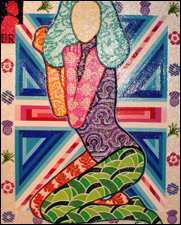
In appreciation: Mixed media on canvas
Sabina Forbes II, from New Jersey in the United States, approached the Court in 2011 with the offer of donating a special commission to its collection. The result is this vibrant work of art, which draws heavily on Forbes' 'Conceptual Bodies' motif.
The viewer can identify a range of the heraldic symbols associated with the Court's jurisdiction around the border and in some of the other segments. Forbes desribes the symbolism on the recessed arm as a pattern created from eagle heads, representing the close friendship between the UK and the US Supreme Courts; and, on the fore arm, the UK's constitutional impact on the wider Commonwealth. The torso features a pattern created from the Omega or Libra symbol, which again can be found in the Supreme Court's official logo.
A limited edition print
by Feliks Topolski RA

This limited edition print was a gift to The Supreme Court from Lord Bingham.
It depicts, from left to right, Lord Upjohn, Lord Evershed and Lord Pearson when they were all Judges of the Appeal Court.
Feliks Topolski was a polish born British painter and draughtsman. He is famous for his pen and ink drawings chronicling contemporary 20th Century life. During the war he was appointed as official war artist. He made portraits of the leading personalities of the 20th century including Gandhi, Churchill and Martin Luther King.
The work is hung in the Justices' Lounge and can be viewed by special appointment.
Dame Margaret Kidd
by an unknown photographer
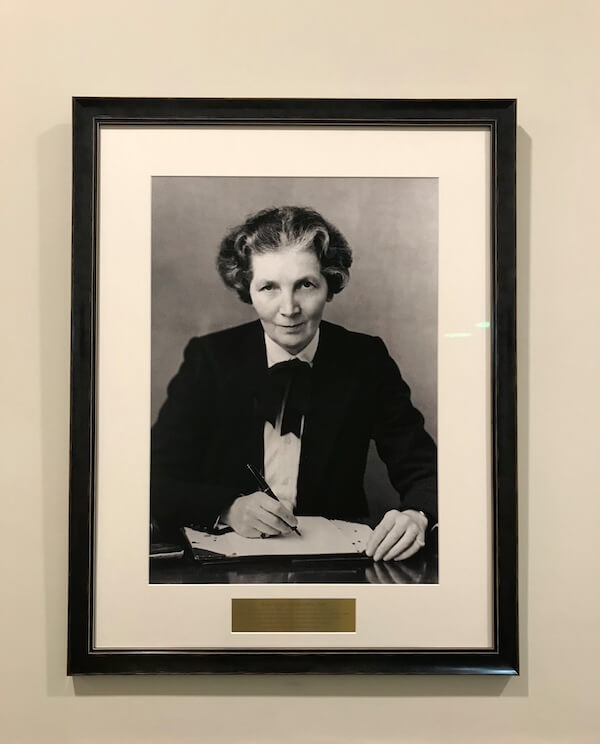
Dame Margaret Henderson Kidd, KC (1900-1989) was the first female member of the Faculty of Advocates in 1923 and remained the only female advocate in Scotland for over 25 years. In 1926 she became the first woman advocate to appear before the House of Lords and before a parliamentary select committee, and the first woman appointed King's Counsel in the UK in 1948. This portrait was donated by the Faculty of Advocates, Edinburgh and is also displayed at the National Galleries of Scotland.

Illustration of Middlesex Guildhall by Stephen Wiltshire
Stephen Wiltshire is one of the United Kingdom's most talented artists. He began drawing as a young boy sketching animals, London buses and then buildings. He is now famous throughout the world and has created panoramic drawings of many major cities. He was diagnosed as autistic when he was three.
The work is hung in the Justices' Lounge and can be viewed by special appointment.
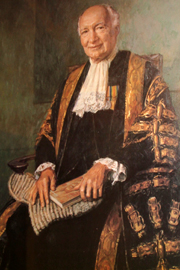
Signed print of Lord Denning, by Michael Noakes
Lord Denning is one of the best known British Judges of the 20th century, and his judgments are still widely studied and quoted.
Denning became a judge in 1944, and was made a Lord Justice of Appeal in 1948 after less than five years in the High Court. He became a Lord of Appeal in Ordinary (a "Law Lord") in 1957 and then returned to the Court of Appeal as Master of the Rolls in 1962, a position he held for twenty years.
The portrait was painted by Michael Noakes, an English artist who has painted many of the world's leading figures. Among those who have sat for him are the Queen, the Prince of Wales, Lady Thatcher, President Clinton and Pope Benedict XVI.
The print was made available to the Court by Miss Julia Francies, who used to run a sandwich bar in Chancery Lane. Lord Denning was a regular customer of the sandwich bar and signed the print for Miss Francies on 4 July 1985. Thereafter it hung in the sandwich bar until the business was sold in 2007.
Side by Side - the sounds and story of Parliament square
Side by Side was commissioned by the Houses of Parliament and the Hansard Society and created by Jonny Pilcher.
With thanks to The Duke and Duchess of Cambridge.
To celebrate Open House London Weekend 2013, the Houses of Parliament and the Hansard Society commissioned sound artist Jonny Pilcher to create Side by Side, a special sound installation celebrating the architecture and history of the buildings surrounding Parliament Square.
The piece was inspired by the Houses of Parliament, Westminster Abbey, HM Treasury and The Supreme Court, featuring previously untold tales from the people who work in and around the Square.
Those interviewed for the installation included an MP, the Lord Speaker, chefs, security officers, Treasury officials, the Abbey's organist and the staff who look after Big Ben, each of whom gave unique insights into the day-to-day workings of Parliament Square's buildings.
Members of staff from The Supreme Court were also interviewed for the project. The Deputy President of the Supreme Court Lady Hale, Chief Executive Jenny Rowe, Court Usher Derek Allen and Information Officer Merida Craxton-Mathen all spoke about their role and work at the Court. They also read Lines for The Supreme Court poem, which was written by the then Poet Laureate Andrew Motion to mark the creation of The Supreme Court in 2009.
Open House London is an annual event giving the public the chance to see inside numerous architecturally significant buildings which are not generally freely open to all. It aims to raise awareness of great buildings and invites people to understand, explore and appreciate architecture in London. The Supreme Court usually takes part in this weekend: details are posted on the homepage of this website.
